Gas-Atomized Nickel Silicide Powders Alloyed with Molybdenum, Cobalt, Titanium, Boron, and Vanadium for Additive Manufacturing
Abstract
:1. Introduction
2. The Ni-Si System and Assessment of Optimum Properties
- Liquid phase—the liquid phase exists at high temperatures and compositions where the alloy is molten.
- Nickel silicide (Ni3Si)—this intermetallic compound forms at high temperatures and low Si concentrations.
- Nickel disilicide (NiSi2)—this phase forms at intermediate temperatures and moderate Si concentrations.
- Nickel monosilicide (NiSi)—this phase forms at lower temperatures and higher Si concentrations.
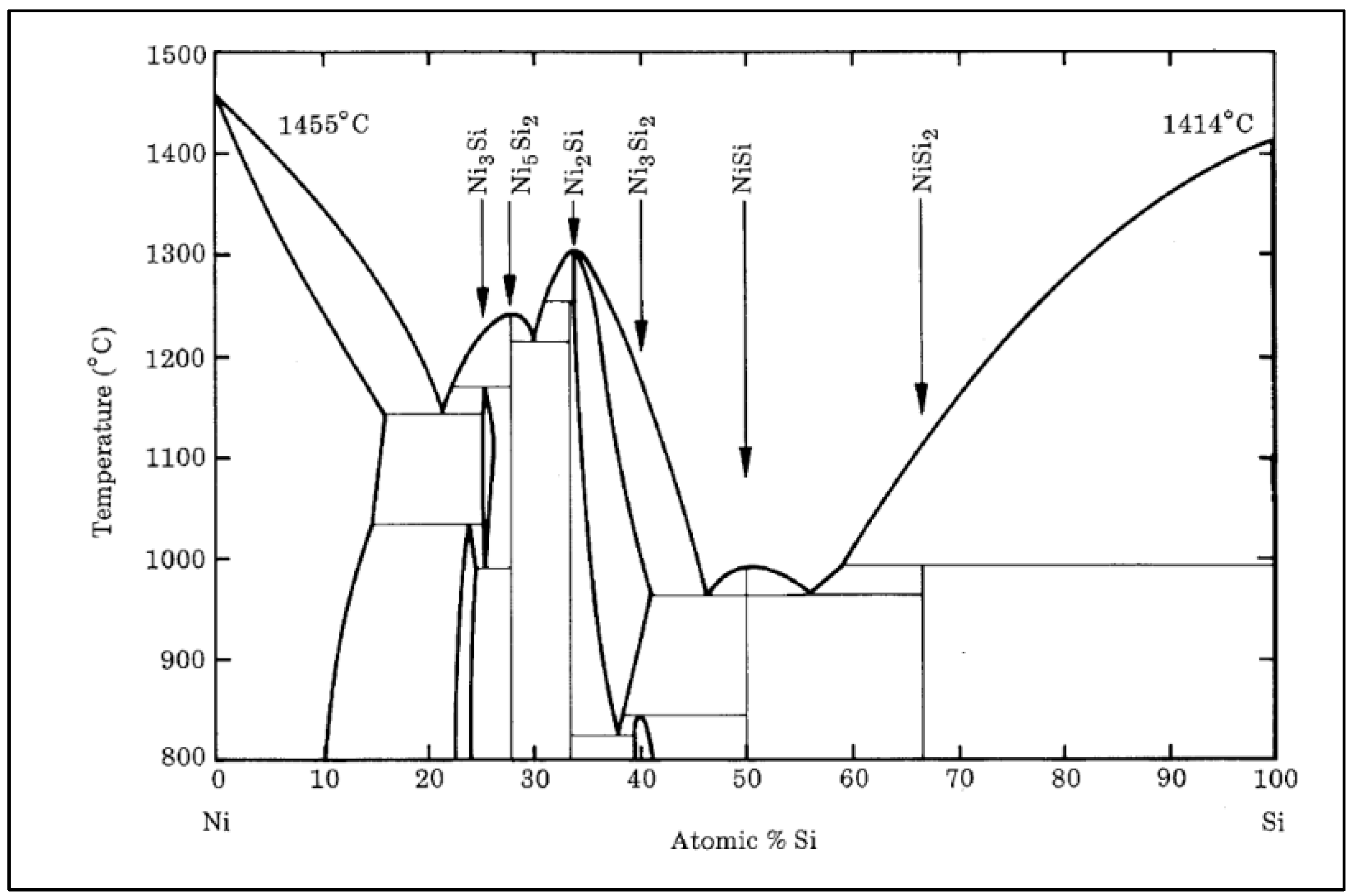
3. Powder Production
4. Powder Characterization
5. Results and Discussion
6. Conclusions
- The presence of small additions of transition metals such as Co, Ti, B, V, and/or Mo could ensure a change in the fracture mode of the NiSi-printed parts from intergranular to transgranular.
- The change in fracture mode will improve the ductility and strength of the produced parts as the added transition metals are segregated to the grain boundaries, thereby restricting the crack propagation within the powders. A similar role is expected from the produced powders in printed parts.
- A variation in relative strength was identified between the produced powder particles as a result of the variation in Si concentration, i.e., NiSiCo (NiSi11.9Co3.4 wt%), NiSiV (NiSi10.15V4.85 wt%), NiSiMo (NiSi11.2Mo1.8 wt%), and NiSiTiB (NiSi10.78Ti1.84B0.1 wt%), and thereby the presence of different phases.
- Porosity was established to exist in some of the produced powder particles with higher surface roughness and an increased number of satellites that may hinder optimum flow conditions during printing, e.g., in the case of NiSiTiB and NiSiV powder particles.
- The gas atomization pressure can be increased to a certain limit (dependent on reactor size and type) to obtain a smaller powder particle size suitable for L-PBF, after which, the satellite formation dominates the powder production method and reduces powder quality.
- Stable printing parts are expected when using the presently produced powder particles once printing parameters are adjusted according to the optimum conditions in each specific case.
7. Future Work
- Flow behavior (evaluated using an FT4 Rheometer).
- Printability (evaluated using Direct Energy Deposition (DED) and Laser Powder Bed Fusion (L-PBF)).
- Chemical and structural analysis (X-ray Photoelectron Spectroscopy (XPS) analyses to evaluate the amount of oxygen (O) adsorbed on the surfaces of the powder particles during transport and environmental exposure).
Author Contributions
Funding
Data Availability Statement
Acknowledgments
Conflicts of Interest
References
- Örnek, C. Additive Manufacturing–A General Corrosion Perspective. Corros. Eng. Sci. Technol. 2018, 53, 531–535. [Google Scholar] [CrossRef]
- Gorsse, S.; Hutchinson, C.; Gouné, M.; Banerjee, R. Additive manufacturing of metals: A brief review of the characteristic microstructures and properties of steels, Ti-6Al-4V and high-entropy alloys. Sci. Technol. Adv. Mater. 2017, 18, 584–610. [Google Scholar] [CrossRef] [PubMed]
- Ibrahim, M.; Sætre, T.O.; Aune, R.E. Laser metal deposition of nickel silicide on S355 structural steel. In Proceedings of the TMS 2022 151st Annual Meeting & Exhibition Supplemental Proceedings, Anaheim, CA, USA, 27 February–3 March 2022; pp. 249–258. [Google Scholar]
- Easton, M.A.; St. John, D.H. Improved Prediction of the Grain Size of Aluminum Alloys that Includes the Effect of Cooling Rate. Mater. Sci. Eng. A 2008, 486, 8–13. [Google Scholar] [CrossRef]
- Totten, G.; Bates, C.; Clinton, N. Residual Stress, Distortion and Cracking. Handb. Quenchants Quenching Technol. 2001, 441–492. [Google Scholar]
- Jang, J.S.; Ou, C.; Cheng, C. The Evolution of Microstructure Change and Mechanical Properties for a Nickel Silicide based Alloy Poped with Carbon and Boron. Mater. Sci. Eng. A 2002, 329, 455–460. [Google Scholar] [CrossRef]
- Xiao, W.; Zhao, Y.; Yang, T. Cubic Ordered Intermetallic Alloys, in Advanced Multicomponent Alloys: From Fundamentals to Applications; Springer: Berlin/Heidelberg, Germany, 2022; pp. 91–103. [Google Scholar]
- Takasugi, T.; Nagashima, M.; Izumi, O. Strengthening and Ductilization of Ni3Si by the Addition of Ti Elements. Acta Metall. Mater. 1990, 38, 747–755. [Google Scholar] [CrossRef]
- Zhang, X.; Niu, M.; Wu, C.; Chen, J. The Effect of Titanium Addition on the Microstructure, Mechanical and Tribological Properties of Ni3Si Alloys Prepared by Powder Metallurgy Method. Mater. Und Werkst. 2019, 50, 1537–1544. [Google Scholar] [CrossRef]
- Taub, A.; Briant, C. Improved Ductility of Ni3Si by Microalloying with Boron or Carbon. Metall. Trans. A 1989, 20, 2025–2032. [Google Scholar] [CrossRef]
- Gibson, I.; Rosen, D.; Stucker, B.; Khorasani, M.; Gibson, I.; Rosen, D.; Stucker, B.; Khorasani, M. Materials for Additive Manufacturing. Addit. Manuf. Technol. 2021, 379–428. [Google Scholar]
- Ünal, A. Effect of Processing Variables on Particle Size in Gas Atomization of Rapidly Solidified Aluminium Powders. Mater. Sci. Technol. 1987, 3, 1029–1039. [Google Scholar] [CrossRef]
- Choong, Y.H.; Krishnan, M.; Gupta, M. A Printability Evaluation of Fine and Coarse Powder in Binder Jetting of Dense and Porous Copper Parts. Prog. Addit. Manuf. 2022, 1–23. [Google Scholar] [CrossRef]
- Nash, P. Phase Diagrams of Binary Nickel Alloys; ASM International Detroit: Detroit, MI, USA, 1991. [Google Scholar]
- Weisert, E. High Alloys to Combat Corrosion. Corrosion Engineering. Sci. Technol. 1957, 13, 61–73. [Google Scholar]
- Liu, Y.; Wang, H. Toughening and Dry Sliding Wear Resistance of Co3Mo2Si Alloys. Wear 2013, 297, 952–957. [Google Scholar] [CrossRef]
- Takasugi, T.; Kawai, H.; Kaneno, Y. The Effect of Cr Adition on Mechanical and Chemical Properties of Ni3Si Alloys. Mater. Sci. Eng. A 2002, 329, 446–454. [Google Scholar] [CrossRef]
- Sun, A.; Chen, Y.; Wang, X.; Han, Q. Ultrafast laser induced NiCrBSi coatings. In IOP Conference Series: Materials Science and Engineering; IOP Publishing: Bristol, UK, 2019; p. 12145. [Google Scholar]
- Guo, Y.; Jia, L.; Kong, B.; Zhang, H.; Zhang, H. Simultaneous Improvement in Fracture Toughness and Oxidation Resistance of Nb-Si based Alloys by Vanadium Addition. Mater. Sci. Eng. A 2017, 701, 149–157. [Google Scholar] [CrossRef]
- Zou, J.; Cheng, J.; Feng, G.; Xie, J.; Yu, F.J.M. Effect of V Addition on Microstructure and Properties of Cu-1.6 Ni-1.2 Co-0.65 Si Alloys. Metals 2019, 9, 679. [Google Scholar] [CrossRef]
- Li, Y.; Lin, X.; Hu, Y.; Yu, J.; Dong, H.; Liu, F.; Huang, W. The Effect of Mo on Microstructure and Mechanical Properties of Nb-22Ti-16Si Alloy Additively Manufactured via Laser Directed Energy Deposition. J. Alloys Compd. 2021, 858, 158143. [Google Scholar] [CrossRef]
- Zhang, P.; Li, M.; Yan, H.; Chen, J.; Yu, Z.; Ye, X. Microstructure Evolution of Ni-Mo-Fe-Si Quaternary Metal Silicide Alloy Composite Coatings by Laser Cladding on Pure Ni. J. Alloys Compd. 2019, 785, 984–1000. [Google Scholar] [CrossRef]
- Takasugi, T.; Yoshida, M. Mechanical Properties of the Ni 3 (Si, Ti) Alloys Doped with Carbon and Beryllium. J. Mater. Sci. 1991, 26, 3032–3040. [Google Scholar] [CrossRef]
- ThermoCalc. Nickel Based Superalloys Databases. Available online: https://thermocalc.com/products/databases/nickel-based-alloys/ (accessed on 20 May 2022).
- Kou, S. A Criterion for Cracking During Solidification. Acta Mater. 2015, 88, 366–374. [Google Scholar] [CrossRef]
- Rappaz, M.; Drezet, J.-M.; Gremaud, M. A New Hot-Tearing Criterion. Metall. Mater. Trans. A 1999, 30, 449–455. [Google Scholar] [CrossRef]
- Brandl, E.; Heckenberger, U.; Holzinger, V.; Buchbinder, D. Additive Manufactured AlSi10Mg Samples using Selective Laser Melting (SLM): Microstructure, High cycle Fatigue, and Fracture Behavior. Mater. Des. 2012, 34, 159–169. [Google Scholar] [CrossRef]
- Olakanmi, E.O.; Cochrane, R.F.; Dalgarno, K.W. A Review on Selective Laser Sintering/melting (SLS/SLM) of Aluminium Alloy Powders: Processing, Microstructure, and Properties. Prog. Mater. Sci. 2015, 74, 401–477. [Google Scholar] [CrossRef]
- Anderson, I.E.; White, E.M.; Dehoff, R. Feedstock Powder Processing Research Needs for Additive Manufacturing Development. Curr. Opin. Solid State Mater. Sci. Eng. A 2018, 22, 8–15. [Google Scholar] [CrossRef]
- Mussatto, A.; Groarke, R.; O’Neill, A.; Obeidi, M.A.; Delaure, Y.; Brabazon, D. Influences of Powder Morphology and Spreading Parameters on the Powder Bed Topography Uniformity in Powder Bed Fusion Metal Additive Manufacturing. Addit. Manuf. Technol. 2021, 38, 101807. [Google Scholar] [CrossRef]
- Hebert, R.J. Metallurgical Aspects of Powder Bed Metal Additive Manufacturing. J. Mater. Sci. 2016, 51, 1165–1175. [Google Scholar] [CrossRef]
- Sakaguchi, Y.; Harada, T.; Kuji, T. Microstructural Studies of Nd Fe B Powders Produced by Gas Atomization. Mater. Sci. Eng. A 1994, 181, 1232–1236. [Google Scholar] [CrossRef]
- Nasrazadani, S.; Hassani, S. Modern Analytical Techniques in Failure Analysis of Aerospace, Chemical, and Oil and Gas Industries. In Handbook of Materials Failure Analysis with Case Studies from the Oil and Gas Industry; Butterworth-Heinemann: Oxford UK, 2016. [Google Scholar]
- Hausner, H.H. (Ed.) Friction conditions in a mass of metal powder. In Secondary Friction Conditions in a Mass of Metal Powder; APMI International: Princeton, NJ, USA, 1967; pp. 7–13. [Google Scholar]
- Chen, G.; Tan, P.; Zhao, S.Y.; He, W.W.; Tang, H. Spherical Ti-6Al-4V Powders Produced by Gas Atomization. Key Eng. Mater. 2016, 704, 287–292. [Google Scholar] [CrossRef]
- Pigozzi, G.; Mukherji, D.; Gilles, R.; Barbier, B.; Kostorz, G. Ni3Si (Al)/a-SiOx Core–Shell Nanoparticles: Characterization, Shell Formation, and Stability. Nanotechnology 2006, 17, 4195. [Google Scholar] [CrossRef] [PubMed]
- Cao, L.; Cochrane, R.F.; Mullis, A.M. Lamella structure formation in drop-tube processed Ni–25.3 at.% Si alloy. J. Alloys Compd. 2014, 615, S599–S601. [Google Scholar] [CrossRef]
- Cao, L.; Cochrane, R.F.; Mullis, A.M. Microstructural Evolution and Phase Formation in Rapidly Solidified Ni-25.3 At. Pct Si Alloy. Metall. Mater. Trans. A 2015, 46, 4705–4715. [Google Scholar] [CrossRef]
- Dutra, A.; Milenkovic, S.; Kiminami, C.; Santino, A.; Goncalves, M.; Caram, R. Microstructure and Metastable Phase Formation in a Rapidly Solidified Ni–Si Eutectic Alloy using a Melt-Spinning Technique. J. Alloys Compd. 2004, 381, 72–76. [Google Scholar] [CrossRef]



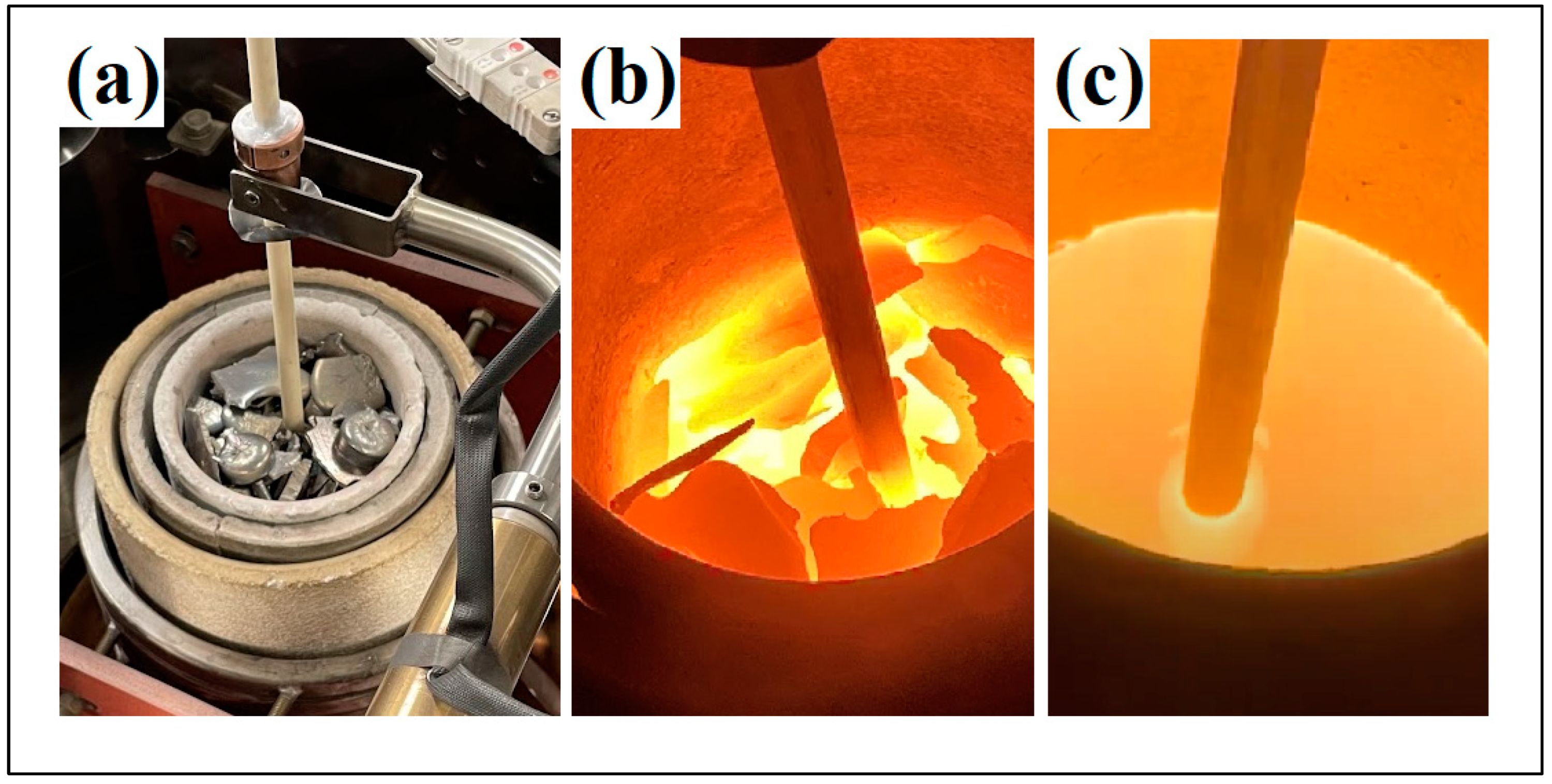
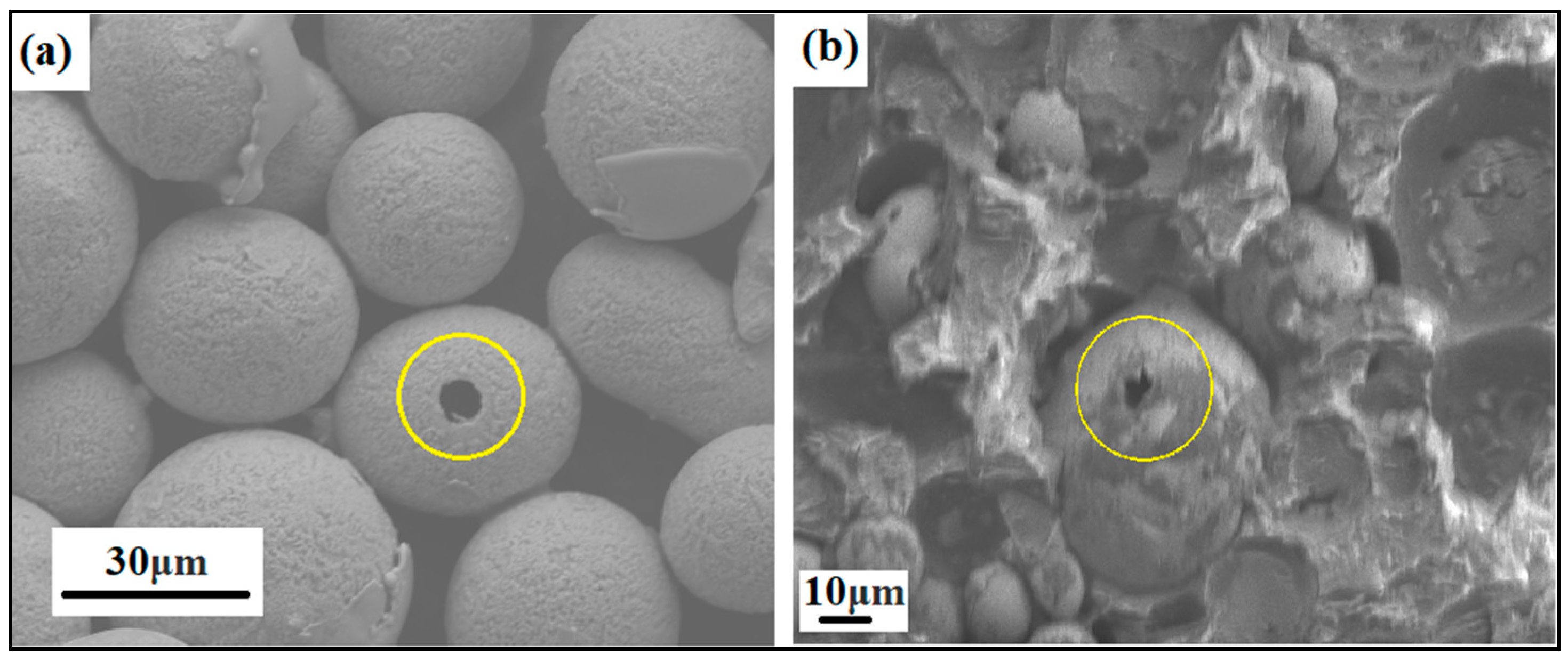
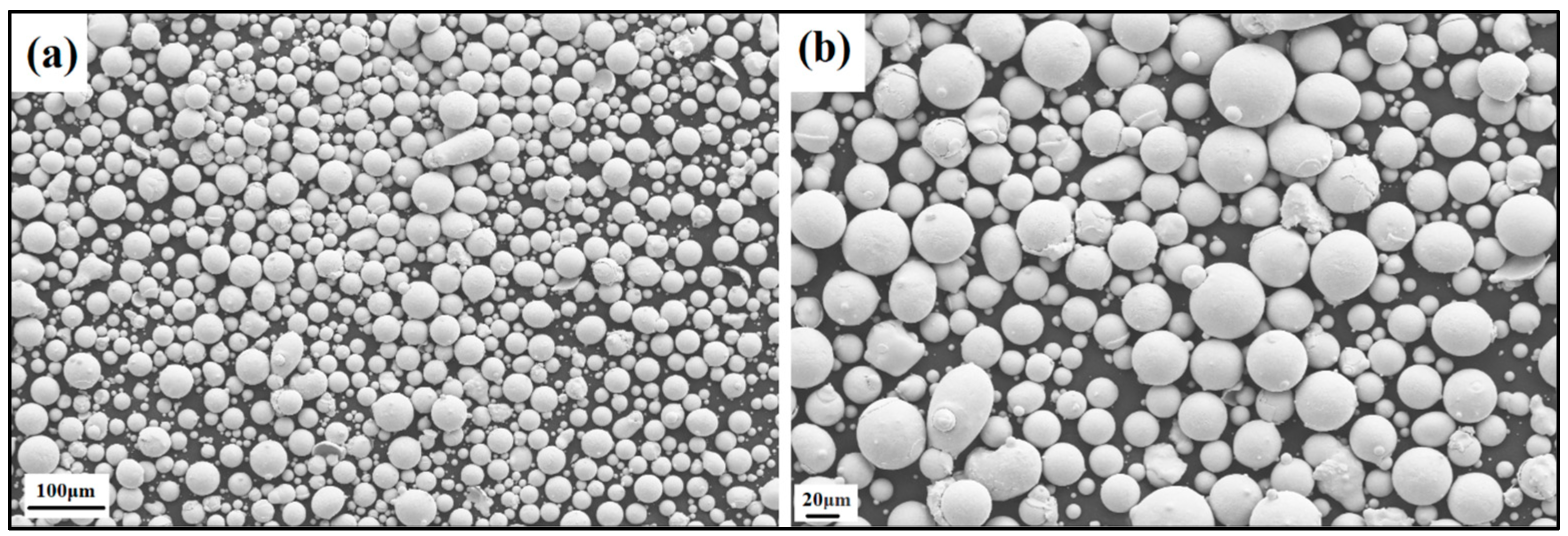


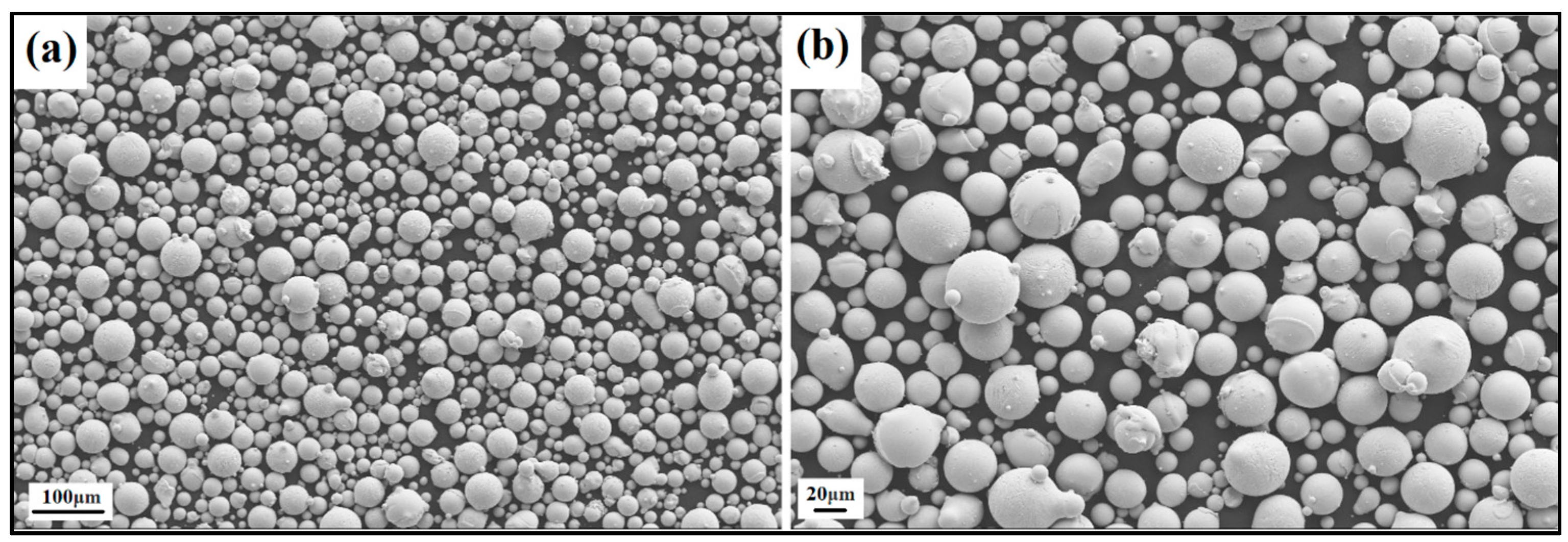
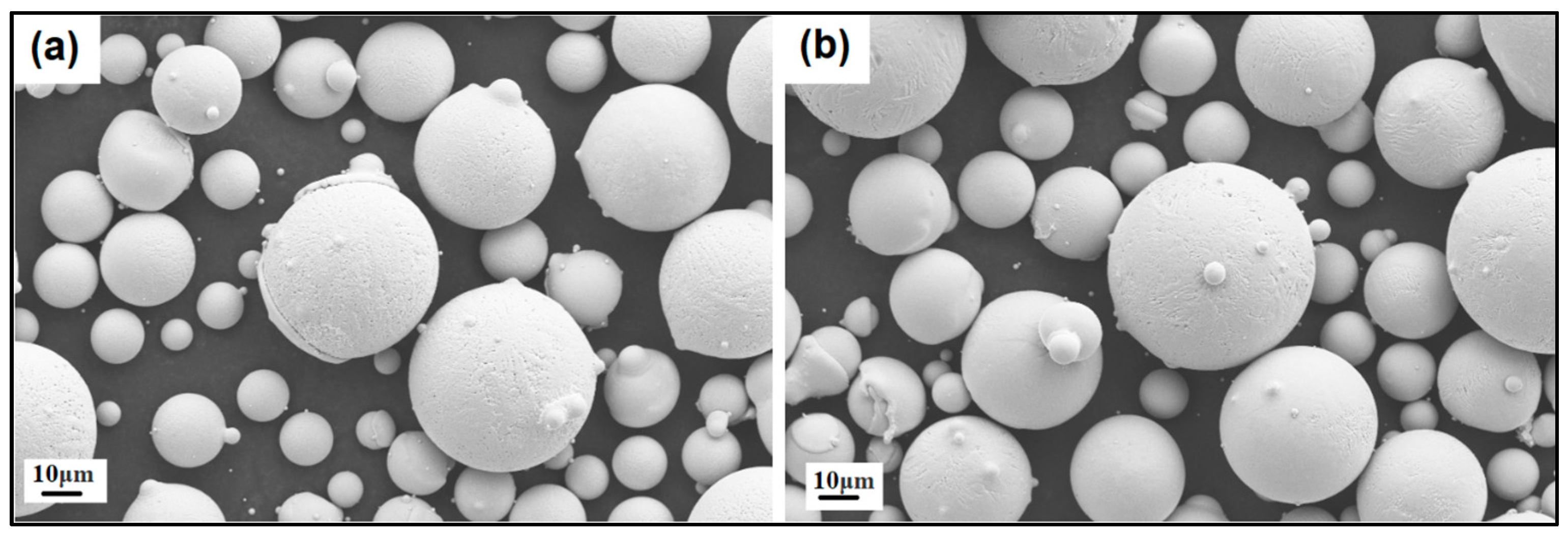

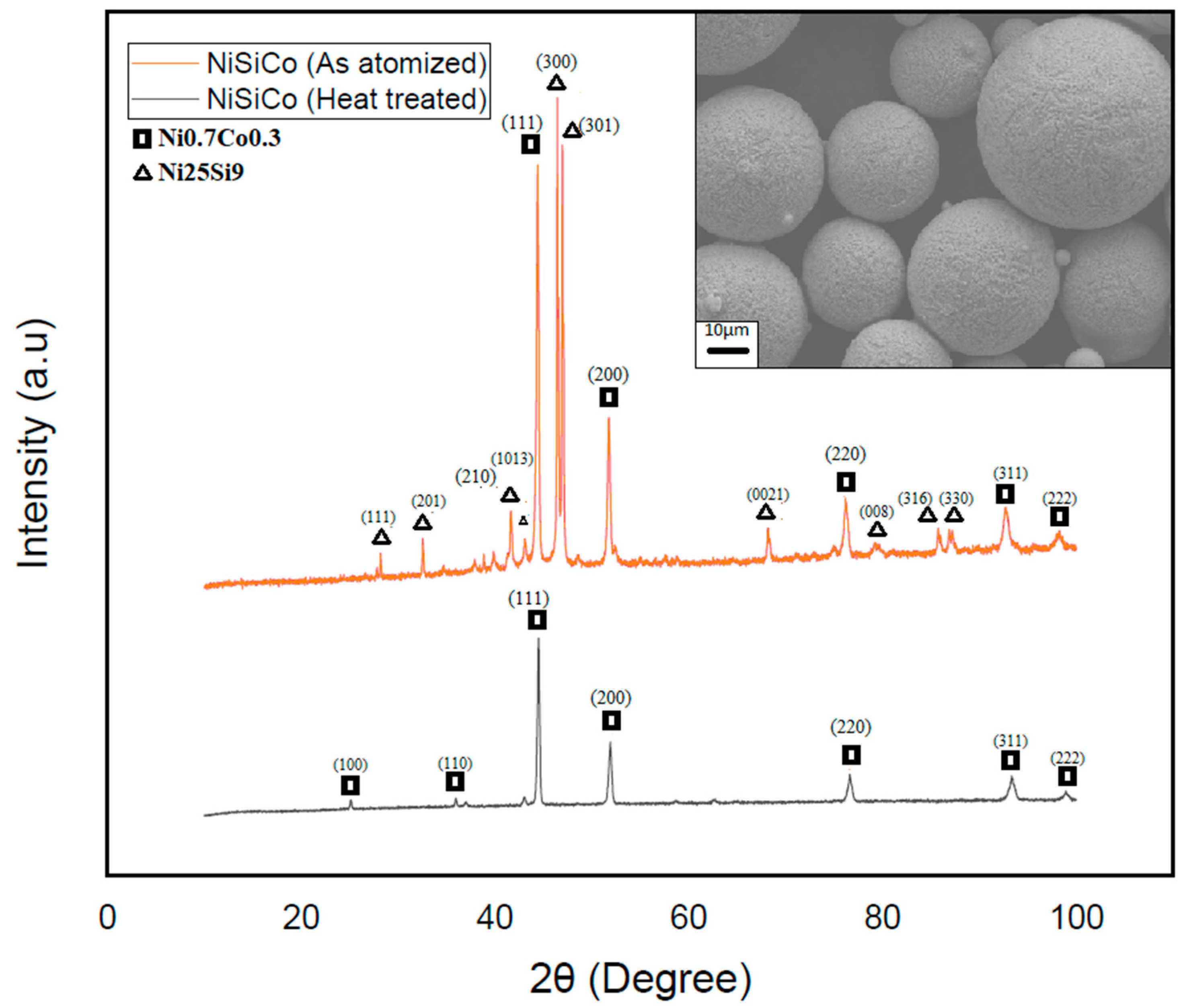
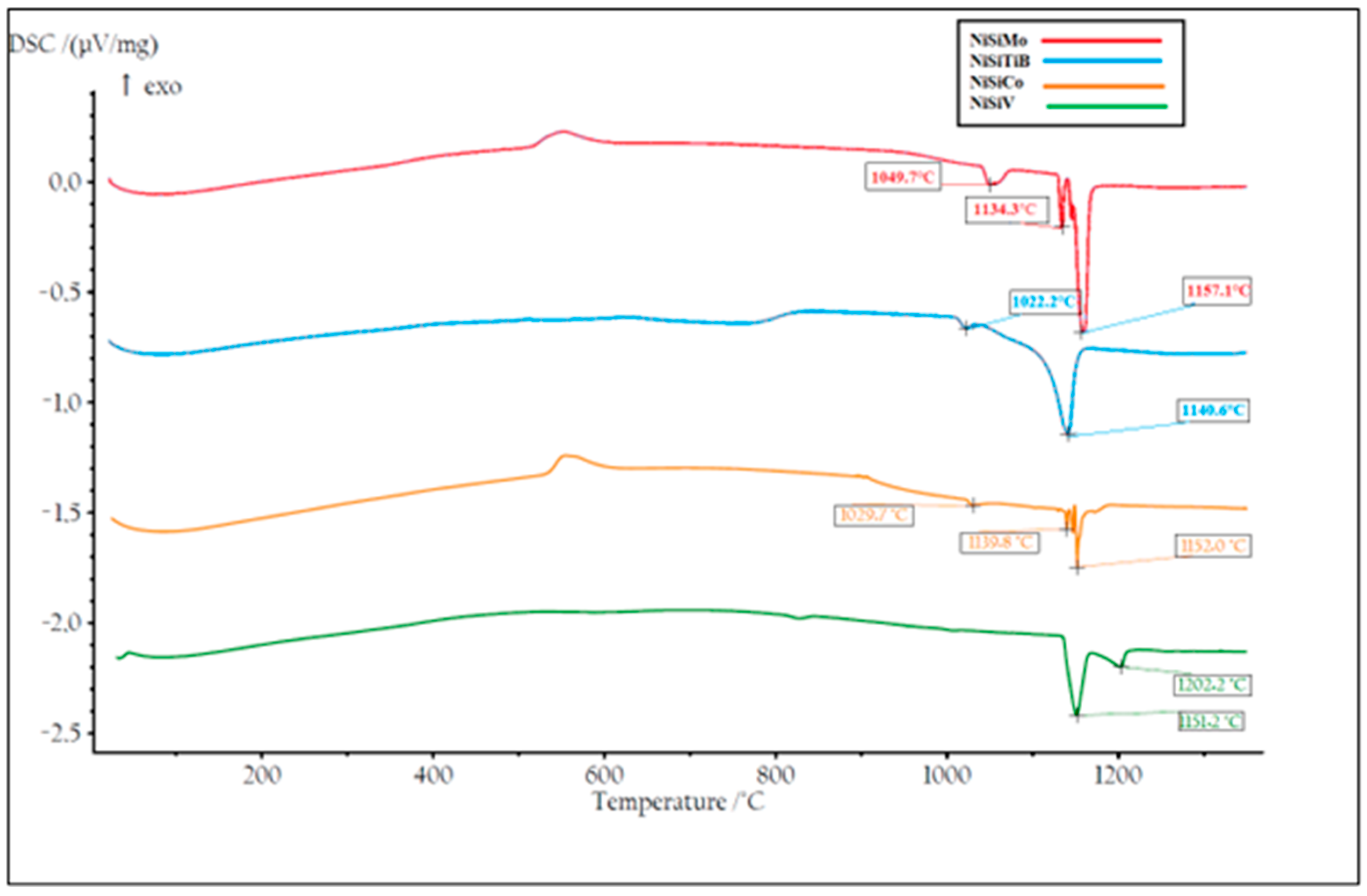
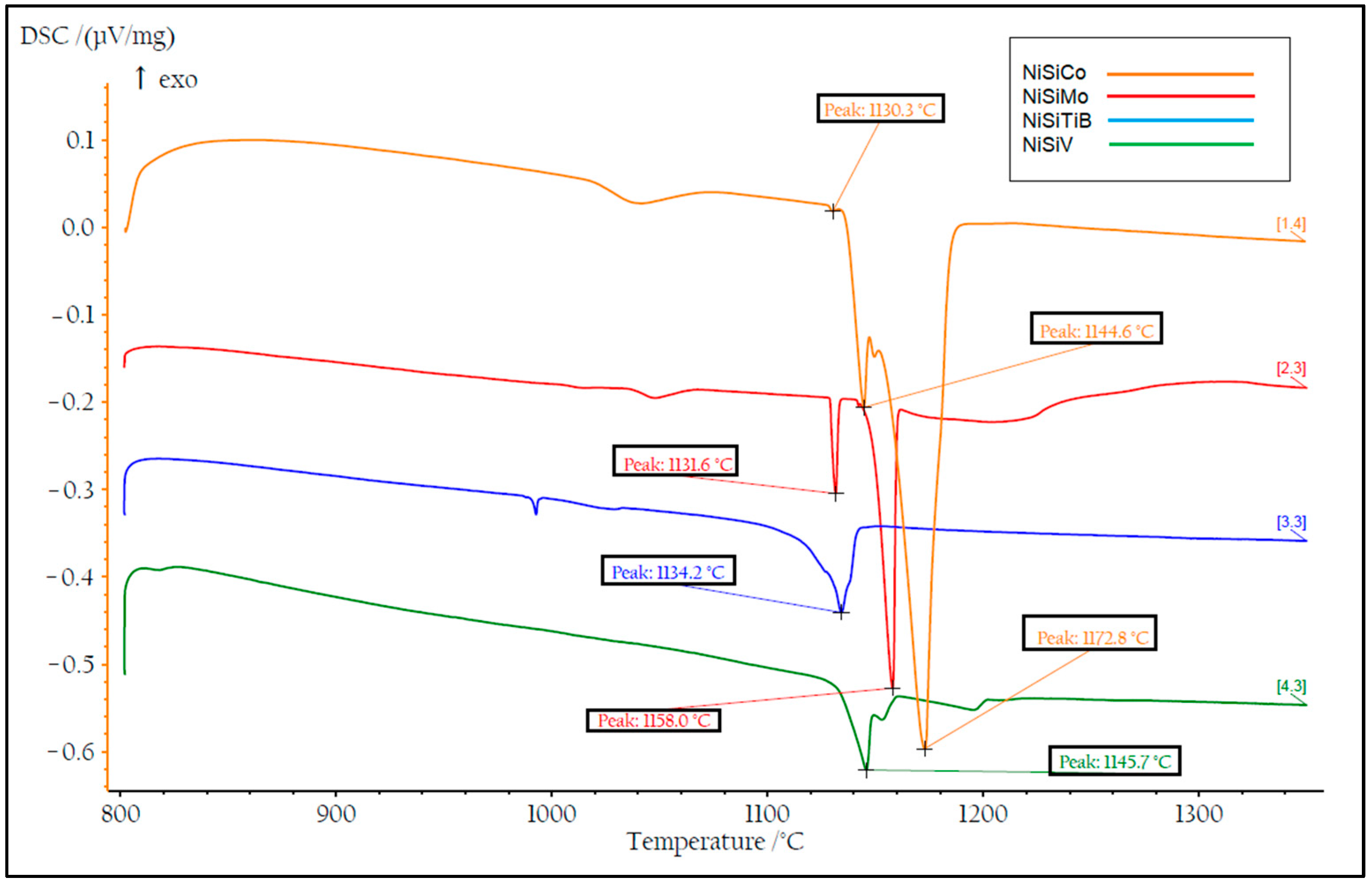
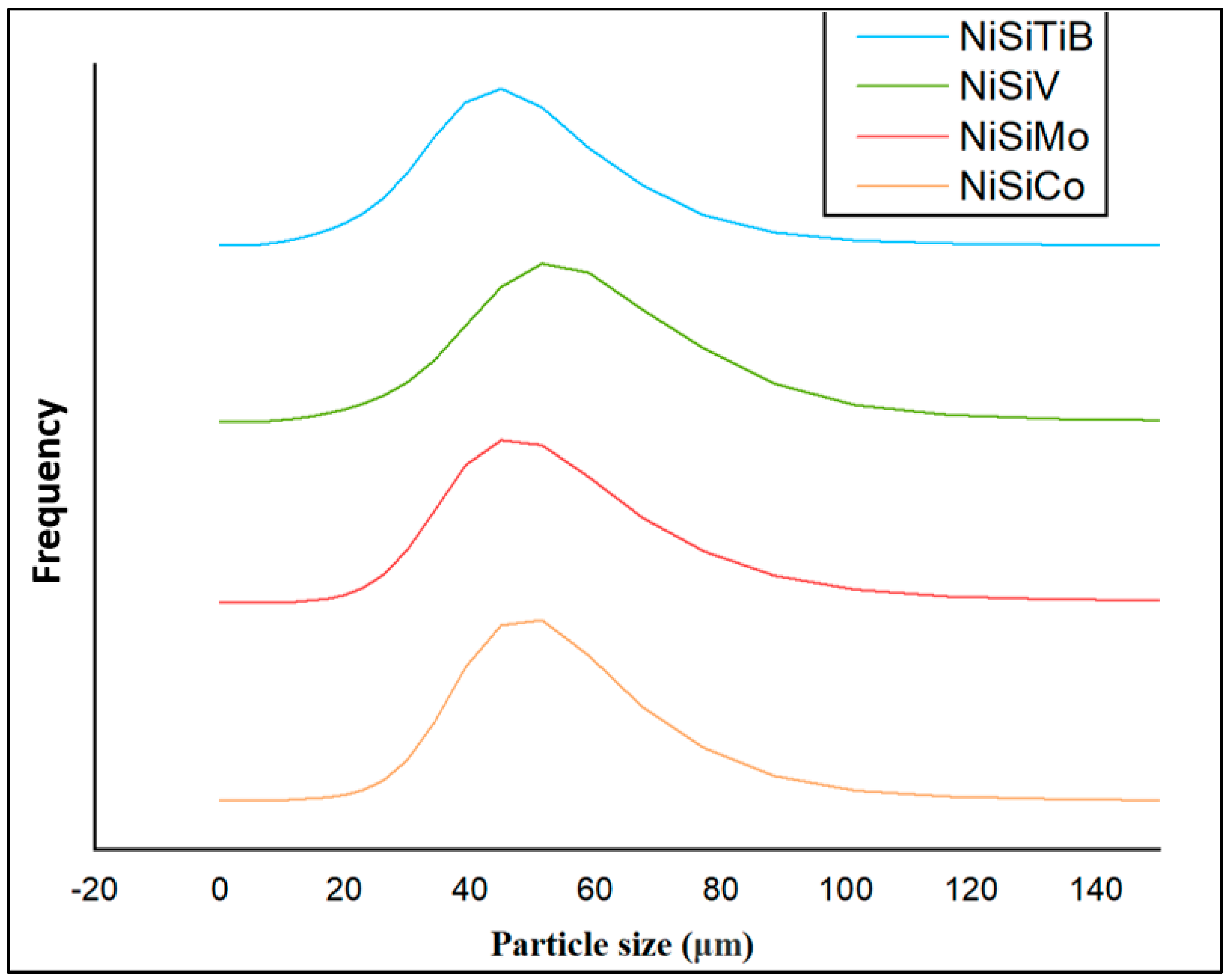
| No. | Added Element | Form | Source | Purity |
|---|---|---|---|---|
| 1 | Ti | - | Titan Plates | Grade 2 |
| 2 | B | Powder, crystalline, −325 mesh | Alfa Aesar | 98% |
| 3 | Ni | Crowns | Nikkelverk, Glencore | 99.8% |
| 4 | Co | - | Nikkelverk, Glencore | 99.95% |
| 5 | Mo | Pellets | Alfa Aesar | 99.7% |
| 6 | V | Pieces < 10 mm | American Elements | 99% |
| 7 | Si | Pieces < 30 mm | Solar grade silicon | 99.995% |
| Alloy | Atomizing Gas Pressure (bar) | Atomizing Temperature (°C) | Yield (25–60 μm/wt. Loaded) (%) |
|---|---|---|---|
| NiSiMo | 42–46 | 1400–1460 | 39.7 |
| NiSiCo | 45–47 | 1410–1460 | 40.41 |
| NiSiTiB | 47 | 1450–1500 | 42.04 |
| NiSiV | 48–51 | 1520–1580 | 37.71 |
| No | Powder Composition | Si Content (wt%) | Ni Content (wt%) | Co Content (wt%) | Mo Content (wt%) | Ti Content (wt%) | V Content (wt%) | B Content (wt%) | C Content (wt%) |
|---|---|---|---|---|---|---|---|---|---|
| 1 | NiSiCo | 14.5 | 77.64 | 6.06 | - | - | - | - | Detected |
| 2 | NiSiMo | 10.45 | 83.17 | - | 2.14 | - | - | - | Detected |
| 3 | NiSiTiB | 10.62 | 80.63 | - | - | 2.30 | - | Detected | Detected |
| 4 | NiSiV | 14.84 | 81.58 | - | - | - | 2.55 | - | Detected |
Disclaimer/Publisher’s Note: The statements, opinions and data contained in all publications are solely those of the individual author(s) and contributor(s) and not of MDPI and/or the editor(s). MDPI and/or the editor(s) disclaim responsibility for any injury to people or property resulting from any ideas, methods, instructions or products referred to in the content. |
© 2023 by the authors. Licensee MDPI, Basel, Switzerland. This article is an open access article distributed under the terms and conditions of the Creative Commons Attribution (CC BY) license (https://creativecommons.org/licenses/by/4.0/).
Share and Cite
Ibrahim, M.; Du, Q.; Hovig, E.W.; Grasmo, G.; Hulme, C.; Aune, R.E. Gas-Atomized Nickel Silicide Powders Alloyed with Molybdenum, Cobalt, Titanium, Boron, and Vanadium for Additive Manufacturing. Metals 2023, 13, 1591. https://doi.org/10.3390/met13091591
Ibrahim M, Du Q, Hovig EW, Grasmo G, Hulme C, Aune RE. Gas-Atomized Nickel Silicide Powders Alloyed with Molybdenum, Cobalt, Titanium, Boron, and Vanadium for Additive Manufacturing. Metals. 2023; 13(9):1591. https://doi.org/10.3390/met13091591
Chicago/Turabian StyleIbrahim, Mohammad, Qiang Du, Even Wilberg Hovig, Geir Grasmo, Christopher Hulme, and Ragnhild E. Aune. 2023. "Gas-Atomized Nickel Silicide Powders Alloyed with Molybdenum, Cobalt, Titanium, Boron, and Vanadium for Additive Manufacturing" Metals 13, no. 9: 1591. https://doi.org/10.3390/met13091591





